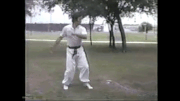Bringing this back to forms, I did go back and try out a few different ways of doing forms. I tried out five ways. The one I'm most used to is in bold.
- Head level, straight step (HS)
- Head level, C step (HC)
- Natural head bob, straight step (NS)
- Natural head bob, C step (NC)
- Sine wave (SW)
NS is what I am most familiar with from Taekwondo. For others, I'm not sure if the choice is done on purpose, or if it's simply a detail they weren't aware of. Looking at some videos of the Palgwe forms, I notice some that do NS and some that do HS. The Taegeuk forms have such shallow stances that it's impossible to tell whether they're trying to keep their head level or not.
Personally, I feel this is the style that
aesthetically works best if you have deep stances and a lot of kicks. Since forms put the "art" in "martial arts", this is the style I would choose for Taekwondo. It just looks better to me if all of your steps appear similar, than if you have some steps that are deep, and then your head just bobs up there for a kick.
NC is a bit of a weird one. Aside from Sine Wave, it's the tallest of the steps, because not only are you straightening the legs, but bringing your feet together makes you taller as well. I can see this being the best at
teaching proper stance width, which is something I've found a lot of beginners struggle with. Beyond that niche use, I don't personally like this. I feel like HC is better training with a C step, and NS looks better. Plus, you can do that c-step drill in other ways to teach the proper stance, which can then be applied to the forms.
SW is a very weird one. I don't think anyone outside of ITF-style TKD does this. It's basically a spring onto the ball of the feet at the apex of the step. I have a lot of opinions in every direction. On the one hand, I agree with the principle that you generate power by pushing off of the ground or by letting gravity bring your strikes into place. However, I think the way sine wave is done in the forms is more of a momentary disconnect from the power of the ground, instead of a push off. And you don't get high enough to generate much potential energy to bring down into the strike.
Forms aren't just about practical application, though. They're also there to look good (as I mentioned above) and for conditioning (which I'll focus on in the next session. I actually do like the bounce as a way to
train calf muscles, which is important for the type of kicking we do in Taekwondo. But aesthetically...it's just weird. This is an opinion (some may like it), but I think it's a general consensus from the non-ITF TKD community that ITF forms are an odd duck.
Last, we have the HS and HC. I don't have as much experience with these, except for playing around with them the last couple of days. I can see both having their merits. I feel the c-step is a bit more aesthetic in this version, because it doesn't accentuate the head bob. However, if the goal is to disguise movement, then the straight step is better. Both keep a more constant stress on your leg. But, is that a better workout than changing levels? It's kind of like the difference between a wall sit and a squat, or between a plank and a sit-up.
Like I said, I think all of these have some merit. I think what's more important is that the person teaching knows
why that particular style of step was chosen, more than which one was chosen. I also don't see any reason you can't mix it up periodically. Either as a student or instructor to mix up the training (so long as the one you do on the test or at the tournament is the "correct" one), or as master creating a new in-house form using a different style.

